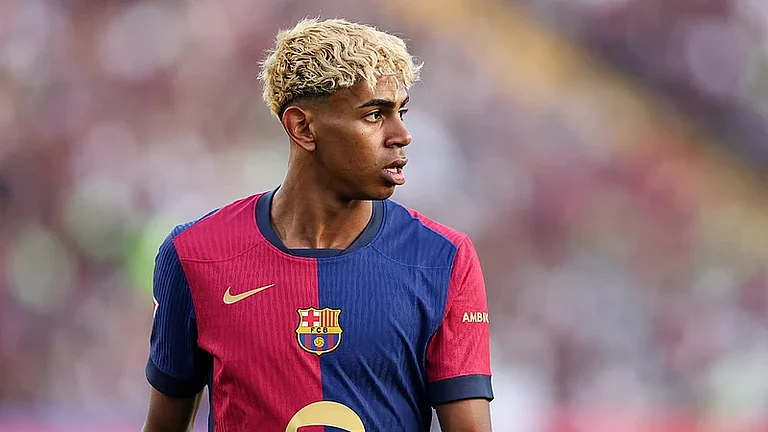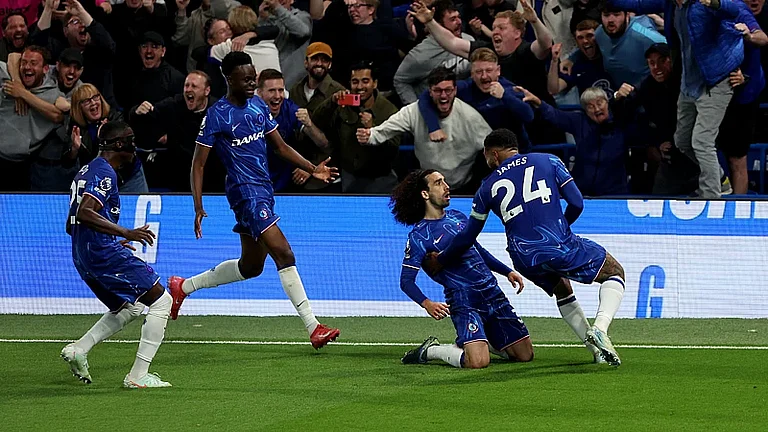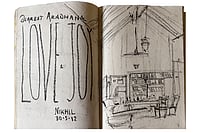“We lived in Bombay and we lived in Mumbai and sometimes, I lived in both of them at the same time.”
— Suketu Mehta, Maximum City: Bombay Lost and Found
From any lane of this wretched place, if you look up, you see the towers like the limbs of an advancing octopus. Menacing. Bombay, the zombie city, is turning everything into a homogenised landscape of towers. Like zombies. It is as if a virus has been unleashed. The skyline of Bombay is mutating. That’s the story of its politics. Finite land and infinite ambition. There are many cities within this city. My Bombay is all this squalor. At doorways, women are on display, here sex is cheap. And in small rooms, women dance and sing in search of patrons. My side of Bombay is all broken buildings and streetwalkers. In this Bombay, you can smell flesh.
All these cities here co-exist and collide with each other. From every highrise, if you look downwards, you see the sprawl of blue tarpaulins that cover the shanties. In Mumbai, that is being forged in steel and glass, there is a lot of hunger for more. They had many names for this city. City of dreams was one such.
All dreams don’t come true in Mumbai. They didn’t come true in Bombay either. I stick with Bombay because that’s the city I went looking for. That’s the city I found in bits and pieces. That’s the absolution that we are looking for. For the city. This city could be an extension of one’s psychological self, documented in notebooks that hold the stories written over a decade. The notebook I am writing this from says on its first page: “Do not allow me to forget you” (BOMBAY). I call it Bombay’s polyphony of individual narratives, including mine who remains an outsider who once lived here. Like this.
Do you know the smell of hope? It comes from the windows of the chawls that look out at the city’s highrises in the nights. The people in those windows look at the ‘other world’ and think, perhaps, that they would one day have a place to love, a space to sit and a bathroom to themselves. I go near the sea and I see couples embracing. Bombay is about people living and loving in small spaces. Adjusting, adapting, fighting back and sometimes, giving up.

At night, the silver wings on the double-decker BEST bus has an unreal glint that subdues the glass and steel buildings around it that represent a futuristic city where street vendors and beggars don’t stake a claim. It is here that capitalism and consumerism reach their crescendo. This is an exercise in surrealism, an irrational juxtaposition, a dream-like scene that encompasses symbolic meanings. It is a bizarre assemblage of objects, limbs, and ideas.
The Flying Bus is an ode to that middle-class life in Mumbai. The red double-decker bus has been operational since 1937, but the numbers have gone down since. This bus is a commemoration of the iconic double decker of Mumbai. Installed in 2012 at Maker Maxity in Bandra Kurla Complex in Mumbai, the artist forewarns us of absence by materialising it. The 9,000 kilos is not just the weight of the artwork but also the burden of nostalgia. Big dreams Public art installation by Sudarshan Shetty titled, The Flying Bus, juxtaposed against the Shiv Sena Bhavan in Dadar.
The river in my village birthed the dream of the sea. They say the rivers surrender to the sea. Cities of water then are the last port. Bombay is a city that eats up the sea. It is always hungry, forever looking to expand but sometimes, the sea surges forward in its fury. And the city...its buildings stand tall overlooking, assessing the waves. From the aeroplane window, Bombay looks like just a speck from this height and I think of the millions of hearts in it trying to wrestle with their concoctions of loneliness. The sea does not end. Nor does the ambition of the land. Inwards, it gobbles up what remains of the past. It is forever redeveloping, overwriting stories and histories. In the various gullies of Kamathipura, I see women looking out of windows with eyes that look sad but not defeated.
***
The silver wings of the Flying Bus pierced the darkness. It reminds you of a strange kind of crossing over where things have lost their functional context and have been transformed into beautiful objects in memory. As a nostalgia object in one’s imagination and memory, it becomes so tragically beautiful. That’s how we live, and that’s how we die. There is the city and the experience. Static, frozen and layered. And it is the art of obituary that we must pay homage to because cities are always changing. The future too will recede into the past. That’s how we go forward, with nostalgia and dread. We lose constantly.
There are scattered images of me. Sometimes, we write half sentences because that’s the closest we can get to translating our experiences. Bombay is overwhelming. That’s the journey of everything. It all culminates in nothing. I try to capture its variety in a panoramic picture of my invisible self, standing near the sea stretching time in this city. It is all about collisions—personal and universal. This city is any city and yet if you have lived in Bombay, you would instantly remember scenes in the local train. And in the end, it is this ode to a city in timelapse that is poetic and encompasses the tragic, the mundane and the metaphysical. They say it is the greatest city. It has the sea and the people, and more windows than stars.
But everyone looks tired and dazed. As if their hearts have been compressed. Bombay slaps you in your face. The poor live like rats and the rich are cocooned in their nests in towers that seem to punch holes in the sky. You wake up disoriented in the Maximum City. You know the minimum wage deal here. It sucks to live in places where you crawl somewhere and spend the night. In some places here, they rent out a bed and the space underneath where they cook and store their belongings and that’s what they call home. In the towers, the windows open up to all kinds of things and, maybe many see the sky and the sea and ignore the filth and the slums. Perhaps that works for them. It is a pretty view. The sky and sea. The sad sights are for those who walk the city. That’s another story.

There’s this song. Rich Folks Hoax by Sixto Rodriguez. And the chorus goes: “So don’t tell me about your success/Nor your recipes for my happiness/Smoke in bed, I never could digest/Those illusions you claim to have going.” Bombay’s rich have rooms and a view. The city’s poor don’t even have windows. How does one capture the city’s variety in a panoramic picture of my invisible self, standing near the sea and stretching time, which makes me understand contrasts. All this compression within a city can turn the sea into land and construct modern buildings, places that might actually have their origins in that estranged politics. All these Bombays interact with each other. Like the man, a migrant and a CEO, did. On that night when it didn’t rain so much and we sat in the shady/seedy bars of Bandra discussing isolation and insulation of the city. And then he said there was this song. “Take the weather with you.” He sent that song.
In the end, it is this ode to a city in timelapse that is poetic and encompasses the tragic, the mundane and the metaphysical. Don’t give up hope yet. There is “deep democracy” at work here. That’s the claim of Bombay over Mumbai.
***
“Cities like Bombay—now Mumbai—have no clear place in the stories told so far that link late capitalism, globalisation, post-Fordism, and the growing dematerialisation of capital. Their history is uneven—in the sense made commonsensical by a certain critical tradition in Marxism. It is also characterised by disjunct, yet adjacent, histories and temporalities. In such cities, Fordist manufacture, craft and artisanal production, service economies involving law, leisure, finance, and banking, and virtual economies involving global finance capital and local stock markets live in an uneasy mix,” writes Arjun Appadurai in Spectral Housing and Urban Cleansing: Notes on Millennial Mumbai.
The ethnicisation of the city happened in late 1992 and early 1993 after the Babri Masjid demolition in Ayodhya on December 6, 1992. An advertisement in the Shiv Sena mouthpiece Saamana, on the occasion of bhoomi pujan for the Ram Temple in Ayodhya on August 5, 2020, had a photo of Balasaheb Thackeray with a statement that read, “I am proud of the men who did this.” Thackeray was one of the accused in the demolition case but was acquitted later. This is also the time when Bombay’s rightwing had participated in anti-Muslim violence, which then unleashed a gradual ethnicising of Bombay, which was tagged as a cosmopolitan city in the 1970s, 1980s, and into the 1990s. Mumbai swapped places with Bombay.
It was Mumbai that I entered in 2003. As the train pulled into VT Station, from its window the city’s boxlike apartment buildings looked like a Rene Magritte painting. A surreal place where everything was juxtaposed to the point it almost looked illogical and dreamlike. I returned in 2012 as a reporter. I was looking for Namdeo Dhasal’s Bombay, Saadat Hasan Manto’s Bombay and Kamathipura, the red-light area. There was something sacred about the minute details. Sensual and holy underneath its grime, this Mumbai retained some of Bombay’s cosmopolitan vibes. The shrines in the brothel where the eunuchs lived in Gully No. 1 had deities from all religions. Even the transgressive were venerated here.
In this Bombay lived the many muses of Manto and Dhasal. These tangible citizens from all backgrounds such as the hermaphroditic madam, the twin bar dancers who kept parrots and rabbits in their tenements, the pimps who hung around, the vendors, the washermen, the other migrants. Here, the portrait of the city achieved more depth. Here, in the tenements of faded lovers and ageing women, there was some of that Bombay left which collapsed the fable of the city of dreams. Here, there were extremes of beauty and brutality.
Everywhere else, the increasing corporatisation and unaffordable glass-box apartments with modular kitchens and a view of the sea or the sky in this post-industrial landscape overshadow Bombay, where mill workers once had jobs and housing. Mumbai, the richest city in India, has more than half of its population living below the poverty line. That’s how stark it gets here. Bombay to Mumbai, from red to saffron, its metamorphosis is always a verb in action. The issue looks at Bombay, Mumbai and what makes up a megapolis that is a seductress, an apocalyptic futuristic place, a place of clash of ideologies, a place of ghettos and billboards. This issue is an attempt to understand the city from people who told me stories about the city, people who are witnesses and participants in its decay. “Bombay is a dying city,” one of them said.
PS: Bombay is also a stream of consciousness anthology.
***
Migrant’s Dilemma
‘Who’s the king of Mumbai?’ shouted the iconic gangster Bhiku Mhatre from the top of a cliff as he stared at the Mumbai skyline, which is forever mutating, in the 1998 film, Satya. They say the skyscrapers have reached up to 100 floors in height in the city. The towers rise like needles. In a city that grows vertically and where the galvanising of the masses once started with a call for “sons of the soil” by Bal Thackeray, the ground is a messy place. They created more land by reclaiming the sea but the conurbation’s politics revolved around the scarcity of land. In the 1990s, when globalisation was introduced, the fabric of the underworld in the city changed. Gangsters in Mumbai entered the real estate. The nexus between politicians and the underworld and the corporate world became more complex. The city metamorphosed. The riots of 1992/93 altered it. The decosmopolitisation of the city gathered speed. Gentrification happened. Former mills became consumerist hubs. Towers came up. The poor couldn’t climb upwards.
In 2020, Manoj Bajpai, a Bollywood actor and a migrant from Bihar, sang and performed a rap song at the Mumbai Central station, the arrival and departure place for trains to India’s Hindi heartland. Bambai Main Ka Ba (What is there in Bombay?) talks of the migrant’s dilemma.
“Du bigha me ghar ba lekin sutal bani tempo me
Zindagi ei ohjrayal bate, nun, tel aur shampoo me
(Back home my house is in a 2 bigha compound but I sleep in a tempo here/And my life here is caught between worrying about salt, oil and shampoo)”, he sang.
Mumbai and Bambai—the two cities amongst the many that exist in its neighbourhoods. And that insulates and accommodates but with terms and conditions. Bombay became Mumbai in 1995. The Sena deemed it so. Bambai Main Ka Ba tells the story of aspiration and rejection by the city of the poor. The Bhojpuri rap calls the city Bambai, which is how the migrants from Northern part of India like Bihar address it as. It was in Bambai that the Shiv Sena under Bal Thackeray targeted migrants from UP and Bihar. It still returns to that rhetoric. But the truth is that its highest towers are inhabited mostly by outsiders. Where do the sons of soils live in this megapolis bursting at its seams?
(This appeared in the print edition as "Pretend it is a City")

























